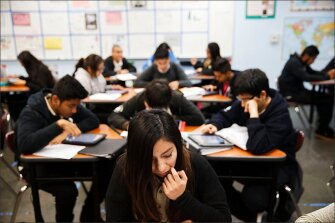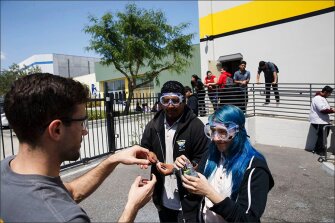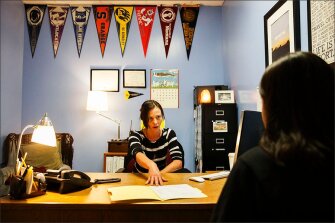Photographer Patrick Fallon writes about his experiences photographing a charter school in Los Angeles, and how it contrasts with the high school he attended.

On my recent assignment for Education Week that chronicled the 25th anniversary of the charter schools movement, I couldn’t help but think of some of the major contrasts of my own large public high school experience and that of the students at Alliance Collins Family College-Ready High School.
The high school that I graduated from in 2007 – Redondo Union High School in Redondo Beach, Calif. – is a massive beast of a campus. It’s the second-largest in area in California at 56 acres—with over 2,700 students. By comparison, the Alliance charter school that I visited has a population of less than a quarter of that and operates inside a shuttered shoe factory in an industrial part of the Los Angeles area. The downtown skyline looms on the northern horizon.

The 100-year-old Redondo campus has views of the Pacific Ocean. It was there where I started working with photography on the school’s yearbook and newspaper staffs, and realized that photographing people and news events could be my job. Friday nights in the fall were spent covering football games and talking to newspaper photographers – some of whom I now work alongside covering events for competing publications.
While some skylights in the campus at Alliance Collins funneled natural light into the hallways, I felt a little starved for natural light and windows as I walked around the school. Going outside for science experiments or meal breaks proved to be a welcome reprieve. Every so often, freight trains rumbled and roared from the tracks that run parallel to the school.
But the lack of natural light and noisy interruptions didn’t detract from the strong intimacy I observed among the students, staff and administrators. While I never felt “lost” at Redondo High, I could easily see how other students there might feel that way. The closer environment of Alliance Collins helps keep everyone connected, focused and more accountable.




I was most impressed by the high college acceptance rate of the 2016 class at Alliance Collins: Every graduating student was accepted into a 4-year university. There was no shortage of posters and banners supporting students in this quest – a visual representation of how the school creates an environment and an expectation that students will go onto, and be ready for college.
It was this very explicit expectation for success that tied both schools together for me. With the right environment and resources, hopefully the future of all students can be shaped to grow positively in high school and enable them to explore their individual talents.




